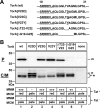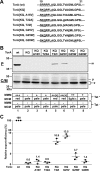The h-region of twin-arginine signal peptides supports productive binding of bacterial Tat precursor proteins to the TatBC receptor complex
- PMID: 28515319
- PMCID: PMC5491773
- DOI: 10.1074/jbc.M117.788950
The h-region of twin-arginine signal peptides supports productive binding of bacterial Tat precursor proteins to the TatBC receptor complex
Abstract
The twin-arginine translocation (Tat) pathway transports folded proteins across bacterial membranes. Tat precursor proteins possess a conserved twin-arginine (RR) motif in their signal peptides that is involved in their binding to the Tat translocase, but some facets of this interaction remain unclear. Here, we investigated the role of the hydrophobic (h-) region of the Escherichia coli trimethylamine N-oxide reductase (TorA) signal peptide in TatBC receptor binding in vivo and in vitro We show that besides the RR motif, a minimal, functional h-region in the signal peptide is required for Tat-dependent export in Escherichia coli Furthermore, we identified mutations in the h-region that synergistically suppressed the export defect of a TorA[KQ]-30aa-MalE Tat reporter protein in which the RR motif was replaced with a lysine-glutamine pair. Strikingly, all suppressor mutations increased the hydrophobicity of the h-region. By systematically replacing a neutral residue in the h-region with various amino acids, we detected a positive correlation between the hydrophobicity of the h-region and the translocation efficiency of the resulting reporter variants. In vitro cross-linking of residues located in the periplasmically-oriented part of the TatBC receptor to TorA[KQ]-30aa-MalE reporter variants harboring a more hydrophobic h-region in their signal peptides confirmed that unlike in TorA[KQ]-30aa-MalE with an unaltered h-region, the mutated reporters moved deep into the TatBC-binding cavity. Our results clearly indicate that, besides the Tat motif, the h-region of the Tat signal peptides is another important binding determinant that significantly contributes to the productive interaction of Tat precursor proteins with the TatBC receptor complex.
Keywords: Escherichia coli (E. coli); membrane transport; protein export; protein targeting; protein translocation.
© 2017 by The American Society for Biochemistry and Molecular Biology, Inc.
Conflict of interest statement
The authors declare that they have no conflicts of interest with the contents of this article.
Figures







Similar articles
-
The early mature part of bacterial twin-arginine translocation (Tat) precursor proteins contributes to TatBC receptor binding.J Biol Chem. 2018 May 11;293(19):7281-7299. doi: 10.1074/jbc.RA118.002576. Epub 2018 Mar 28. J Biol Chem. 2018. PMID: 29593092 Free PMC article.
-
Signal Peptide Hydrophobicity Modulates Interaction with the Twin-Arginine Translocase.mBio. 2017 Aug 1;8(4):e00909-17. doi: 10.1128/mBio.00909-17. mBio. 2017. PMID: 28765221 Free PMC article.
-
Genetic evidence for a tight cooperation of TatB and TatC during productive recognition of twin-arginine (Tat) signal peptides in Escherichia coli.PLoS One. 2012;7(6):e39867. doi: 10.1371/journal.pone.0039867. Epub 2012 Jun 26. PLoS One. 2012. PMID: 22761916 Free PMC article.
-
Mechanistic Aspects of Folded Protein Transport by the Twin Arginine Translocase (Tat).J Biol Chem. 2015 Jul 3;290(27):16530-8. doi: 10.1074/jbc.R114.626820. Epub 2015 May 14. J Biol Chem. 2015. PMID: 25975269 Free PMC article. Review.
-
Targeting of proteins to the twin-arginine translocation pathway.Mol Microbiol. 2020 May;113(5):861-871. doi: 10.1111/mmi.14461. Epub 2020 Feb 20. Mol Microbiol. 2020. PMID: 31971282 Free PMC article. Review.
Cited by
-
Cross-Species Functional Conservation and Possible Origin of the N-Terminal Specificity Domain of Mitochondrial Presequences.Front Plant Sci. 2020 Feb 13;11:64. doi: 10.3389/fpls.2020.00064. eCollection 2020. Front Plant Sci. 2020. PMID: 32117399 Free PMC article.
-
Structural features of the TatC membrane protein that determine docking and insertion of a twin-arginine signal peptide.J Biol Chem. 2017 Dec 29;292(52):21320-21329. doi: 10.1074/jbc.M117.812560. Epub 2017 Oct 31. J Biol Chem. 2017. PMID: 29089385 Free PMC article.
-
Advancements in Escherichia coli secretion systems for enhanced recombinant protein production.World J Microbiol Biotechnol. 2025 Mar 3;41(3):90. doi: 10.1007/s11274-025-04302-0. World J Microbiol Biotechnol. 2025. PMID: 40025370 Review.
-
Routing of thylakoid lumen proteins by the chloroplast twin arginine transport pathway.Photosynth Res. 2018 Dec;138(3):289-301. doi: 10.1007/s11120-018-0567-z. Epub 2018 Aug 12. Photosynth Res. 2018. PMID: 30101370 Review.
-
Signal peptides for recombinant protein secretion in bacterial expression systems.Microb Cell Fact. 2018 Mar 29;17(1):52. doi: 10.1186/s12934-018-0901-3. Microb Cell Fact. 2018. PMID: 29598818 Free PMC article. Review.
References
-
- Denks K., Vogt A., Sachelaru I., Petriman N. A., Kudva R., and Koch H. G. (2014) The Sec translocon mediated protein transport in prokaryotes and eukaryotes. Mol. Membr. Biol. 31, 58–84 - PubMed
-
- Robinson C., Matos C. F., Beck D., Ren C., Lawrence J., Vasisht N., and Mendel S. (2011) Transport and proofreading of proteins by the twin-arginine translocation (Tat) system in bacteria. Biochim. Biophys. Acta 1808, 876–884 - PubMed
-
- Hou B., and Brüser T. (2011) The Tat-dependent protein translocation pathway. Biomol. Concepts 2, 507–523 - PubMed
-
- Palmer T., and Berks B. C. (2012) The twin-arginine translocation (Tat) protein export pathway. Nat. Rev. Microbiol. 10, 483–496 - PubMed
MeSH terms
Substances
LinkOut - more resources
Full Text Sources
Other Literature Sources
Molecular Biology Databases

